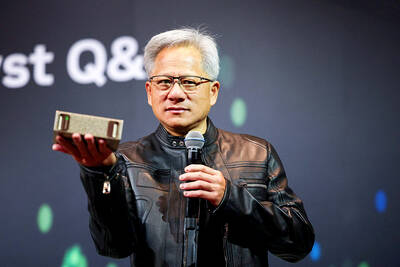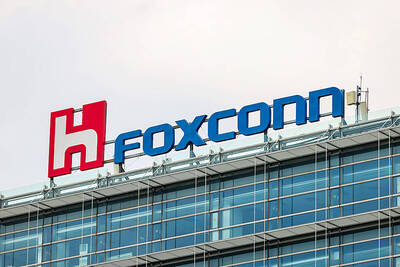The increasing memory density of servers will continue to drive demand for server memory, DRAMexchange, a research division of Taipei-based TrendForce Corp (集邦科技), said in a report on Thursday.
Server DRAM sales are expected to record 28.6 percent growth next year, the highest among all the DRAM product lines, the report said.
Moreover, the supply-demand dynamics for DRAM products will remain tight next year, with contract prices of server DRAM likely to grow further, by between 5 percent and 8 percent in the first quarter of next year, following substantial growth of 40 percent this year, the report said.
DRAMexchange said that in addition to Intel Corp’s and Advanced Micro Devices Inc’s (AMD) introduction of new server processors this year, new data center construction projects carried out by Alphabet Inc’s Google, Amazon.com Inc’s Web service unit, Facebook Inc and Microsoft Corp’s Azure cloud platform also boost the demand for server DRAM.
As for mainstream DRAM modules, price quotes for 32 gigabyte (GB) server modules from first-tier factories will hit US$300 per unit and prices will be even higher at second-tier plants, supporting high price levels during the first quarter of next year, the report said.
Driven by the surging demand for servers at data centers, global server shipments could grow 5.53 percent next year from this year, DRAMexchange said.
The demand for servers has soared in recent years due to industrial transformation and growing popularity of “smart” devices, DRAMexchange said, adding that the market shows growing demand for servers to integrate services, especially those requiring large amounts of data for computation and training, as well as those provided by virtual platforms and by cloud storage providers.
Hewlett Packard Enterprise Co, Dell Inc and Lenovo Group Ltd (聯想) are the top three server suppliers, the report said, adding that the three companies are expected to retain their dominance in the global server market next year, with market shares of 17 percent, 16 percent and 7 percent respectively in terms of shipments.
This year, the three companies’ market shares were 18 percent, 17 percent and 7 percent respectively, the report said.
Based on DRAMexchange’s analysis, a data center requires 10 million to 20 million GB of server DRAM on average.
By 2020, major global data centers will be carrying out more than 10 construction projects worldwide, of which more than 80 percent will be initiated by North American companies, the researchers said.
On the other hand, the Chinese data center market is also growing on the back of the government’s supportive policies, it said, adding that the yearly growth rate is projected to remain between 20 percent and 30 percent until 2020.

SEEKING CLARITY: Washington should not adopt measures that create uncertainties for ‘existing semiconductor investments,’ TSMC said referring to its US$165 billion in the US Taiwan Semiconductor Manufacturing Co (TSMC, 台積電) told the US that any future tariffs on Taiwanese semiconductors could reduce demand for chips and derail its pledge to increase its investment in Arizona. “New import restrictions could jeopardize current US leadership in the competitive technology industry and create uncertainties for many committed semiconductor capital projects in the US, including TSMC Arizona’s significant investment plan in Phoenix,” the chipmaker wrote in a letter to the US Department of Commerce. TSMC issued the warning in response to a solicitation for comments by the department on a possible tariff on semiconductor imports by US President Donald Trump’s

‘FAILED EXPORT CONTROLS’: Jensen Huang said that Washington should maximize the speed of AI diffusion, because not doing so would give competitors an advantage Nvidia Corp cofounder and chief executive officer Jensen Huang (黃仁勳) yesterday criticized the US government’s restrictions on exports of artificial intelligence (AI) chips to China, saying that the policy was a failure and would only spur China to accelerate AI development. The export controls gave China the spirit, motivation and government support to accelerate AI development, Huang told reporters at the Computex trade show in Taipei. The competition in China is already intense, given its strong software capabilities, extensive technology ecosystems and work efficiency, he said. “All in all, the export controls were a failure. The facts would suggest it,” he said. “The US

The government has launched a three-pronged strategy to attract local and international talent, aiming to position Taiwan as a new global hub following Nvidia Corp’s announcement that it has chosen Taipei as the site of its Taiwan headquarters. Nvidia cofounder and CEO Jensen Huang (黃仁勳) on Monday last week announced during his keynote speech at the Computex trade show in Taipei that the Nvidia Constellation, the company’s planned Taiwan headquarters, would be located in the Beitou-Shilin Technology Park (北投士林科技園區) in Taipei. Huang’s decision to establish a base in Taiwan is “primarily due to Taiwan’s talent pool and its strength in the semiconductor

French President Emmanuel Macron has expressed gratitude to Hon Hai Precision Industry Co (鴻海精密) for its plan to invest approximately 250 million euros (US$278 million) in a joint venture in France focused on the semiconductor and space industries. On his official X account on Tuesday, Macron thanked Hon Hai, also known globally as Foxconn Technology Group (富士康科技集團), for its investment projects announced at Choose France, a flagship economic summit held on Monday to attract foreign investment. In the post, Macron included a GIF displaying the national flag of the Republic of China (Taiwan), as he did for other foreign investors, including China-based